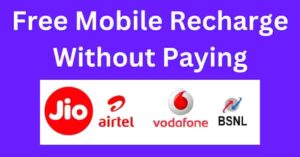Free mobile recharge offers have become increasingly popular as users seek ways to reduce their monthly telecom expenses. While many legitimate promotions exist from authorized providers, the internet is flooded with fake “recharge hack” apps and websites promising unrealistic benefits. Understanding the difference between genuine offers and potential scams is crucial for mobile users who want to save money without compromising their security or violating terms of service.
Legitimate Ways to Get Free Mobile Recharge

Cashback and Reward Apps
Several authorized platforms provide real opportunities to earn free or discounted recharges:
- Google Pay offers scratch cards and cashback on recharges
- PhonePe provides regular discounts and reward points
- Paytm runs frequent promotional offers
- Mobikwik has SuperCash redemption options
These apps partner directly with telecom operators and provide transparent terms for earning recharge benefits through normal financial transactions.
Telecom Operator Promotions
All major carriers run official programs:
- Jio’s referral program gives ₹50 per successful sign-up
- Airtel Thanks rewards convert usage into benefits
- Vi’s weekend data packs offer bonus data
These are the safest options as they come directly from service providers without middlemen.
Survey and Task-Based Rewards
Some legitimate platforms convert user activity into recharge credits:
- Google Opinion Rewards pays for short surveys
- CashKaro provides cashback on online shopping
- Amazon Mechanical Turk offers microtask earnings
While these require time investment, they provide real value without security risks.
Identifying and Avoiding Recharge Scams
Common Characteristics of Fake Offers
Fraudulent platforms often exhibit these red flags:
- Claims of “unlimited free recharge”
- Requests for sensitive information (OTPs, passwords)
- Poorly designed websites with grammatical errors
- No verifiable company information
- Pressure tactics (“Offer expires in 10 minutes!”)
Popular Scam Methods to Watch For
- Fake code generators that steal login credentials
- “VPN recharge hack” apps containing malware
- Pyramid schemes disguised as referral programs
- Fake customer care numbers that phish for details
Security Best Practices
Protecting Yourself from Fraud
- Only use official app stores for downloads
- Verify any offer on the telecom provider’s website
- Never share OTPs or UPI PINs
- Check app permissions before installing
- Use unique passwords for financial accounts
What to Do If Scammed
- Immediately contact your bank if payments were made
- Inform your telecom provider
- Report to cybercrime authorities
- Change all related passwords
- Monitor accounts for suspicious activity
Alternative Ways to Reduce Recharge Costs
Smart Usage Strategies
- Optimize data usage with tracking apps
- Take advantage of WiFi calling
- Use messaging apps instead of SMS
- Schedule downloads during off-peak hours
Value-Added Plans
- Annual packs often provide 15-20% savings
- Family plans reduce per-user costs
- Corporate offers through employers
Conclusion: Safe Savings vs. Risky Shortcuts
While the temptation of completely free recharges is strong, the safest and most sustainable approach combines legitimate reward programs with smart usage habits. Telecom operators themselves offer numerous ways to reduce costs through official promotions and optimized plans. By avoiding suspicious “hack” offers and focusing on authorized methods, users can enjoy genuine savings without risking security violations or financial loss. Remember that if an offer seems too good to be true, it almost certainly is – especially in the world of mobile recharges.